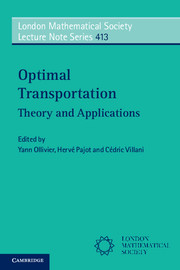Book contents
- Frontmatter
- Contents
- List of contributors
- Preface
- PART 1 SHORT COURSES
- 1 Introduction to optimal transport theory
- 2 Models and applications of optimal transport in economics, traffic, and urban planning
- 3 Logarithmic Sobolev inequality for diffusion semigroups
- 4 Lecture notes on variational models for incompressible Euler equations
- 5 Ricci flow: the foundations via optimal transportation
- 6 Lecture notes on gradient flows and optimal transport
- 7 Ricci curvature, entropy, and optimal transport
- PART 2 SURVEYS AND RESEARCH PAPERS
- References
5 - Ricci flow: the foundations via optimal transportation
from PART 1 - SHORT COURSES
Published online by Cambridge University Press: 05 August 2014
- Frontmatter
- Contents
- List of contributors
- Preface
- PART 1 SHORT COURSES
- 1 Introduction to optimal transport theory
- 2 Models and applications of optimal transport in economics, traffic, and urban planning
- 3 Logarithmic Sobolev inequality for diffusion semigroups
- 4 Lecture notes on variational models for incompressible Euler equations
- 5 Ricci flow: the foundations via optimal transportation
- 6 Lecture notes on gradient flows and optimal transport
- 7 Ricci curvature, entropy, and optimal transport
- PART 2 SURVEYS AND RESEARCH PAPERS
- References
Summary
Overview
Since the creation of Ricci flow by Hamilton in 1982, a rich theory has been developed in order to understand the behaviour of the flow, and to analyse the singularities that may occur, and these developments have had profound applications, most famously to the Poincaré conjecture. At the heart of the theory lie a large number of a priori estimates and geometric constructions, which include most notably the Harnack estimates of Hamilton, the L-length of Perelman (in the spirit of Li-Yau), the logarithmic Sobolev inequality arising from Perelman's W-entropy, and the reduced volume of Perelman, amongst others.
The objective of these lectures is to explain this theory from the point of view of optimal transportation. As I explain in Section 5.4, Ricci flow and optimal transportation combine rather well, and we will see fundamental but elementary aspects of this when we see in Theorem 5.2 how diffusions contract under reverse-time Ricci flow. However, the key to the whole theory is to realise to which object one should apply this result: not the original Ricci flow, but a new Ricci flow derived from the original one, on a base manifold of one higher dimension, that we call the canonical soliton. In this way, essentially the entire foundational theory of Ricci flow mentioned above drops out naturally.
Throughout the lectures I emphasise the intuition; the objective is to demonstrate how one can discover the theory rather than treat it as a black box that just happens to work.
- Type
- Chapter
- Information
- Optimal TransportTheory and Applications, pp. 72 - 99Publisher: Cambridge University PressPrint publication year: 2014
References
- 2
- Cited by

